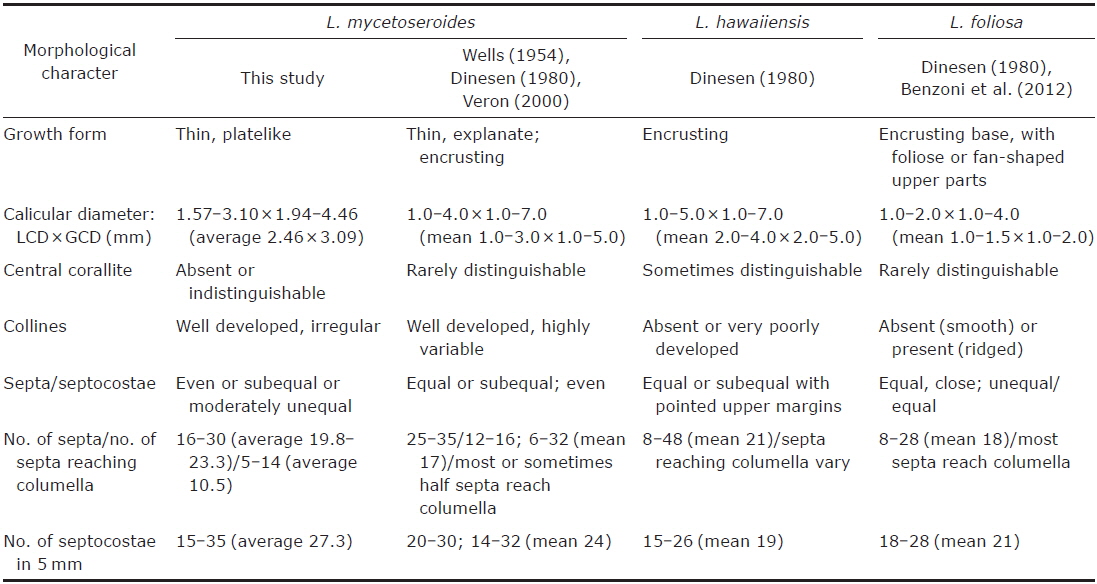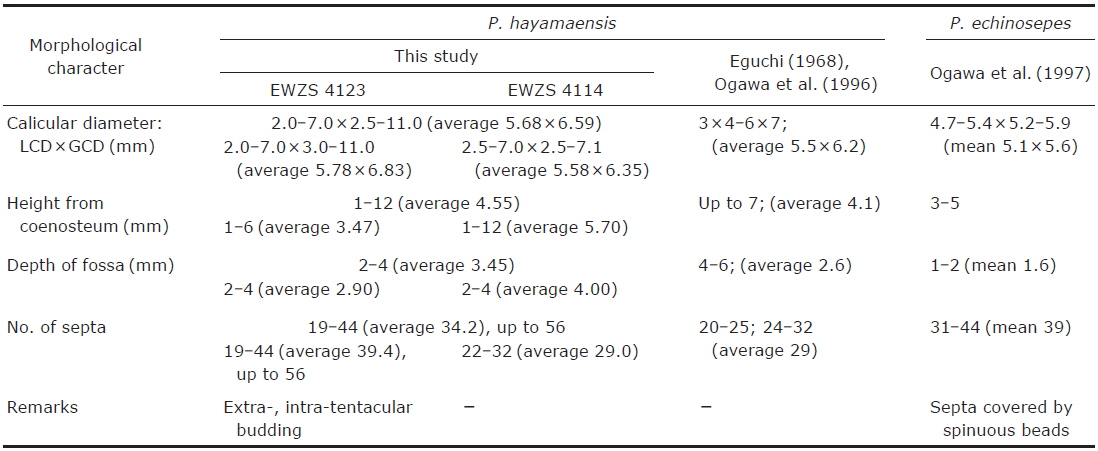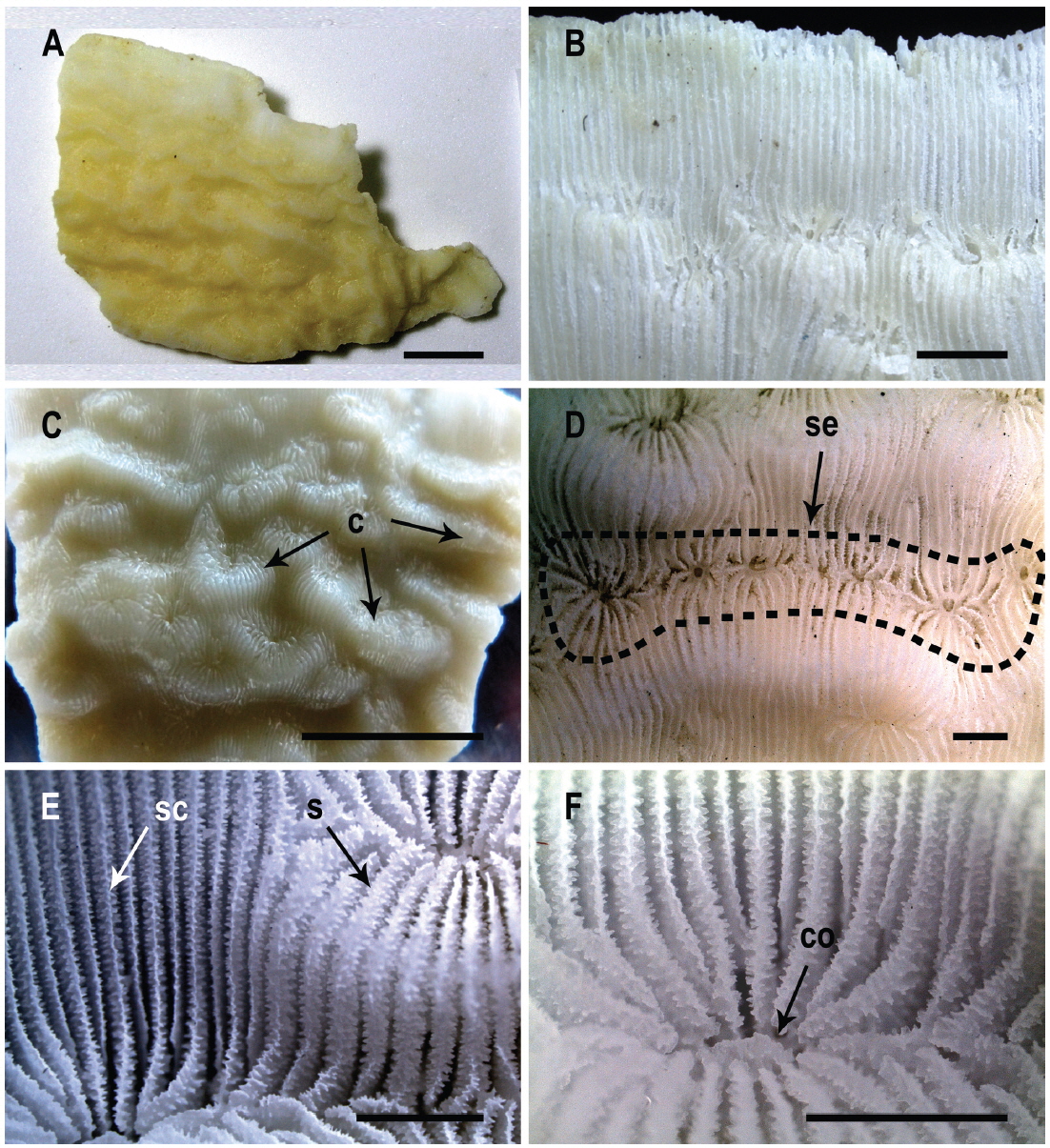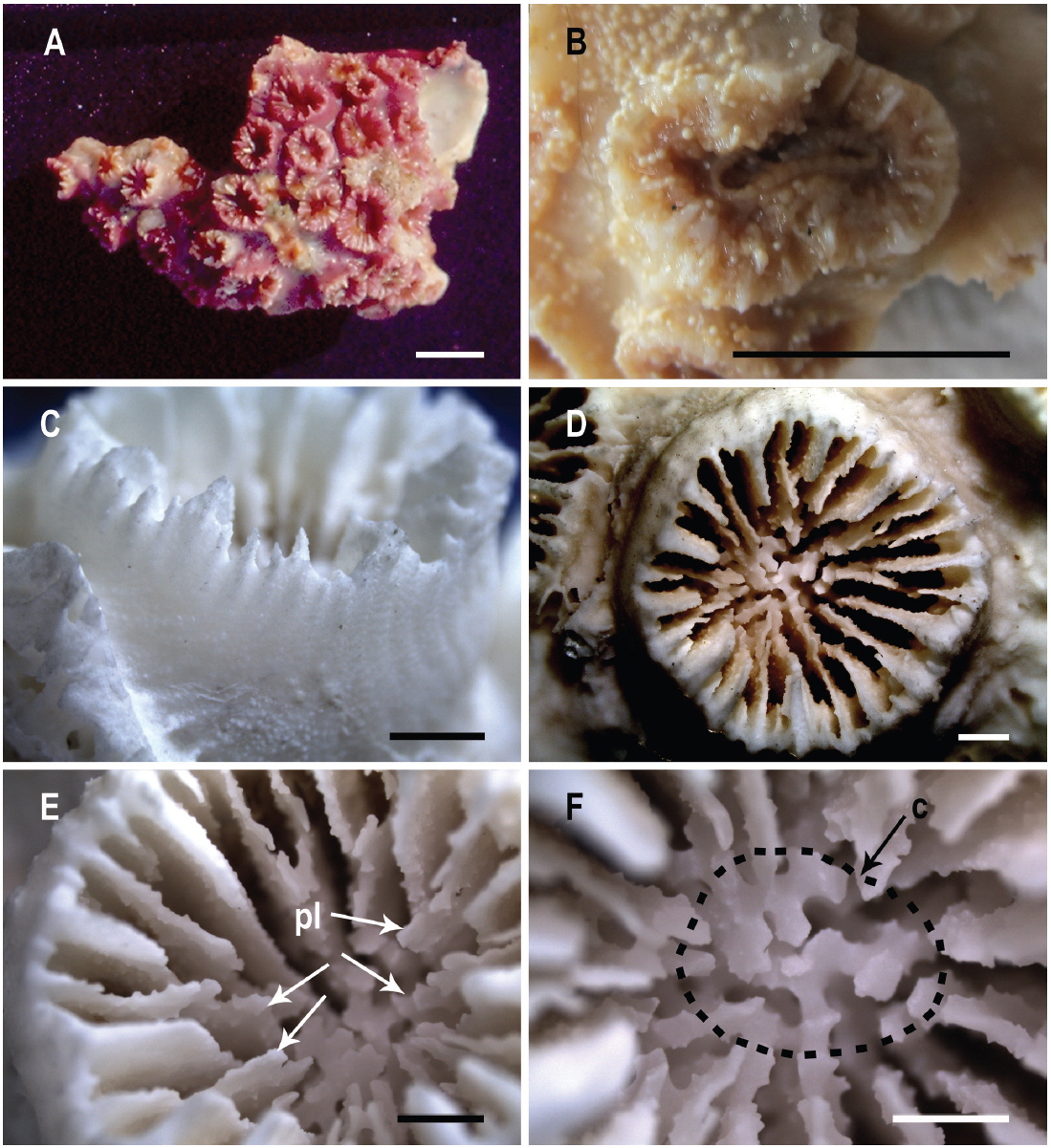



Two scleractinian species are newly recorded in Korea: Leptoseris mycetoseroides
The family Agariciidae Gray, 1847 includes seven genera and 47 species (Kitahara et al., 2012), 18 species of which belong to the genus
On the other hand, no species of the family Agariciidae and six species of the family Caryophylliidae have been recorded in Korea (Song, 1982, 1988, 1991, 2004; Song and Lee, 1998):
This study describes two new records of scleractinian species from Korea:
The specimens were collected from the subtidal zones off Mara-do, Chagwi-do, and Seopseom in Jeju-do Island, Korea by SCUBA diving from 1991 to 2007. The specimens were dissolved in sodium hypochlorite solution with distilled water for 24 hours to remove all soft parts, washed in distilled water, and dried to examine the skeletal structures. The growth forms and shapes of coralla were photographed with digital cameras (G12; Canon Inc., Tokyo, Japan and Optio WG2; Pentax Ricoh Imaging Co. Ltd., Tokyo, Japan). The skeletal structures of corallites were observed with a stereomicroscope (Leica S8APO; Leica Microsystems, Wetzlar, Germany), photographed with a mounted camera (Leica Microsystems), and measured with an image analyzer (LAS Ver. 3.6; Leica Microsystems). Multi-focused images were taken in series and combined with an image editing program (HeliconFocus 5.3 Pro; Helicon Soft Ltd., Kharkov, Ukraine) to provide clear images of the detailed skeletal structures. The classification of scleractinians in the present study partly followed Wells (1956), Veron (2000), and Roberts et al. (2009). The morphological terms were referenced from Wells (1956), Dinesen (1980), and Cairns and Kitahara (2012). The specimens examined in this study are deposited at the Ewha Womans University Natural History Museum, Korea.
Phylum Cnidaria Hatschek, 1888
Class Anthozoa Ehrenberg, 1834
Subclass Hexacorallia Haeckel, 1866
Order Scleractinia Bourne, 1900
Family Agariciidae Gray, 1847
Diagnosis. Corallum solitary or colonial, attached. Growth form encrusting, massive, columnar, foliose, branching mainly by intratentacular budding. Septa rarely porous. Septal faces covered by granules. Columella present or absent.
Diagnosis. Corallum solitary or colonial, attached. Growth form encrusting, massive, columnar, foliose, branching mainly by intratentacular budding. Collines present or absent. Proximal cushions or hydnophoroid projections present or absent. Central corallite present or absent. Septa and septocostae even or alternating. Columella present or absent.
Material examined. Korea: Jeju-do: 1 ind., Seogwipo-si, Seopseom, 10 Sep 2007, Hwang SJ, Cho IY, 10 m deep by SCUBA diving (EWZS 1022).
Description. Corallum colonial, attached. Growth form platelike or explanate by intratentacular budding from corallite margins. Corallum part of thin plate, unifacial, 35-60 mm in width, 1-3 mm in thickness. Upper surface striated distinctively, thinner towards margins of corallum. Under surface glossy, smooth, striated indistinctively at inner parts of corallum, but striated distinctively at margins of corallum. Corallites sunken, concave, irregularly scattered or in series of 2-7 centers (average 3.4 centers) per row enclosed by collines, inclined towards margins of corallum. 2-6 corallites (average 4 corallites) in 5×5 mm, but corallites rarer at margins of corallum. Central or parent corallite absent or indistinguishable indistinguishable. Collines enclosing corallites irregularly, but well developed. Distance between collines 1.47-6.29 mm (average 3.40 mm). Intercorallite distance within series 0.60-3.01 mm (average 1.54 mm). Intercorallite distance between series 2.16-5.23 mm (average 3.23 mm). Calice elliptical or circular or slightly polygonal or irregular, 1.57-3.10×1.94-4.46 mm (average 2.46×3.09 mm) in diameter. Fossa elliptical or circular, 0.18-0.26×0.25-0.70 mm (average 0.23×0.38 mm) in diameter, approximately 0.4 mm or shallow in depth. Columella single styliform, 0.06-0.12×0.09-0.47 mm (average 0.09×0.19 mm) in diameter. Corallite wall not developed. Exsertness and thickness of septa and septocostae vary. Septa thin, even or subequal or moderately unequal, imperforate, spiny, straight in general, contorted, thickened near outer calicular margins. 16-30 septa (average 19.8-23.3 septa) per corallite. 5-14 septa (average 10.5 septa) reaching columella. Septal upper margins rounded. Septocostae 3-7 (average 5.5) in 1 mm, 0.08-0.22 mm (average 0.14 mm) in thickness (including thickness of septal lateral spines) at inner parts of corallum, 5-6 (average 5.8) in 1 mm, 0.08-0.15 mm (average 0.10 mm) in thickness at margins of corallum. Space between septocostae 0.03-0.07 mm (average 0.05 mm) in thickness at inner parts of corallum, 0.09-0.15 mm (average 0.12 mm) in thickness at margins of corallum.
Color. Coenosarc brown.
Habitat. This species inhabits subtidal zones of 10 m in depth. Tube worms, and hydroids live in ectosymbiosis on the corallum.
Remarks.
[Table 1.] Comparison of Leptoseris mycetoseroides morphological characters with two similar species

Comparison of Leptoseris mycetoseroides morphological characters with two similar species
Distribution. Pacific Ocean: Korea (Jeju-do Island), Japan (Southern Honshu, Southern Shikoku, Southern Kyushu, Okinawa), Taiwan, Philippines, Indonesia, Celebes, Australia (Great Barrier Reef), Houtman Abrolhos Island, Solomon Islands, Marshall Islands; Indian Ocean: Madagascar, Reunion, Mauritius, Saya de Malha, Chagos Archipelago.
Family Caryophylliidae Dana, 1846
Diagnosis. Corallum solitary or colonial, free or attached. Colony formed mainly by extratentacular budding. Theca well developed. Septa exsert. Septa laminar with smooth inner edges. Septal arrangement usually hexamerous. Pali or paliform lobes present or absent. Columella present or absent.
Diagnosis. Corallum colonial, attached. Growth form encrusting or reptoid. Septa hexamerously arranged in multiple cycles. Septal inner edges smooth. Columella present. Pali or paliform lobes present.
Material examined. Korea: Jeju-do: 1 ind., Seogwipo-si, Mara-do, 25 Oct 1991, Song JI, Won JH (EWZS 4123); 1 ind., Jeju-si, Chagwi-do, 6 Nov 2000, Song JI, 20-25 m deep (EWZS 4114).
Description. Corallum colonial, attached. Growth form encrusting mainly by extratentacular budding forming plocoid or reptoid colony of corallites, united basally with thick common coenosteum. Intratentacular budding observed. Corallum 45-60 mm in width, 4-40 mm in height. 13-17 corallites (average 14.8) in 30×30 mm. Intercorallite distance 4-14 mm (average 8.56 mm). Corallite cylindrical, 2.0-7.0×2.5-11.0 mm (average 5.68×6.59 mm) in calicular diameter, 1-12 mm (average 4.55 mm) in height from common coenosteum. Calice elliptical or circular. Fossa 2-4 mm (average 3.45 mm) in depth. Columella trabecular or fusions of septal inner edges or spongy, 0.85-2.01×1.03-2.85 mm (average 1.47×1.77 mm) in diameter. Theca thick, minutely granulated. Costae weakly present at upper outer thecal margins. Coenosteum non-costate, well developed. Septa irregularly, but hexamerously arranged in general from 19 to 44 in 3-4 cycles (average 34.2 in 4 incomplete cycles). Up to 56 (23+33) septa developed in enlarged corallite of intratentacular budding. All septal upper margins exsert above thecal wall. Inner edges of S1, S2 entire, vertical, smooth, those of S3 dentate. S1>S2>S3>>S4 or S1>S3>S2>>S4. Pairs of S3 curved towards, united before common S2. S4 rudimentary. All septa except S4 fused with columella. Paliform lobes irregularly shaped and arranged before S3. Septal lateral faces minutely granulated.
Color. Coenosarc pink.
Habitat. This species inhabits subtidal zones of 20-25 m in depth. Bryozoans, tube worms, hydroids, oysters, sponges and barnacles live in ectosymbiosis on the corallum.
Remarks. In the original paper (Eguchi, 1968), this species was named as
[Table 2.] Comparison of Phyllangia hayamaensis and P. echinosepes morphological characters

Comparison of Phyllangia hayamaensis and P. echinosepes morphological characters
Distribution. Pacific Ocean: Korea (Jeju-do Island), Japan (Southern Honshu).



